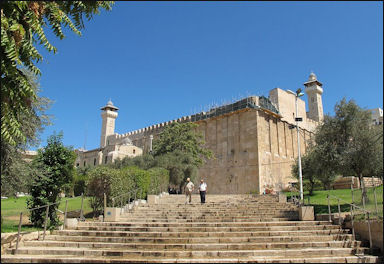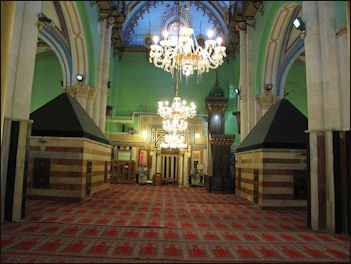INTIFADA I

Intifada 1990 The “Intifada” (Arabic for "shaking off") was a grassroots uprising carried out by Palestinians in the occupied territories that protested the occupation and the control in the territories by the Israelis and told the Israelis to wake up and recognize their presence and concerns. The Palestinians were proud of the Intifada and in the end it helped forced the Israelis into peace talks and win the Palestinians limited self rule.
The Intifada began on December, 9 1987 in Jabaliya, a depressing refugee camp in the Gaza Strip, when Palestinian youths began throwing rocks at Israeli soldiers that were part of the occupying force. The uprising then spread to the West Bank and other places in the Gaza Strip. Their efforts grew into an organized movement that lasted until 1994. Most of the fighting was between high-school-age Palestinian youths and university-age Israeli soldiers. Around 1,000 Palestinians and 85 Israelis were killed, and by one count 112,000 trees were uprooted and 1,882 houses were destroyed.
For the first time, the international community began shifting their sympathy from the Israelis to the Palestinians who seemed to be the victims of Israeli ruthlessness. Television footage showed images of heavily-armed Israeli soldiers firing at Palestinian youths armed with only Molotov cocktails, rocks, slings and slingshots among burning tires and makeshift barricades.
Tactics employed by the Palestinians included work stoppages and strikes, but mostly the protests consisted of teenage boys hurling rocks and Molotov cocktails at Israeli patrols or cars with yellow Israeli plates (leaving alone those with blue Arab plates). One Palestinian described it as “a kind of exorcism to throw a stone at Satan.” The most violent activities by the Palestinians were knifings of Israelis in the cities and the occasion spray of bullets on West Bank settlements. Israeli soldiers said the Palestinian youths were expert marksmen with their rocks: "They know exactly when to throw the stone so it hits the windshield of the car, and if the car is going fast enough, it will kill the driver." [Source: Tad Szulc, National Geographic, June 1992 [♥]
Palestinian Fighters and Israeli Soldiers in the Intifada
Palestinians that participated in the Intifada said they became involved in the protests because "there is nothing else that can help us." Those that got caught by the Israeli were often beat and left without food, some say, for nine days or more. In a U.S. State Department report the Israelis were castigated for subjecting Palestinian prisoners to "hooding; deprivation of food, sleep, and sanitary facilities; forced standing; and confinement in a narrow small space.” Palestinian Intifada participants bragged about the number of times they were jailed and their performance under Israeli interrogation. ♥

Fences were built around refugee camps and refugees were only allowed to come and go through a single gate. People were arrested. Homes were raided in the middle of the night. Houses were bulldozed. Rubber bullets and tear gas were fired into crowds. In some West Bank towns young Palestinian were roused in the middle of the night and forced to clean up anti-Israeli graffiti sprayed on the walls.
Some Israelis felt empowered by their brutal crackdowns. One Israeli soldier told National Geographic, "Walk up to someone, punch them in the face, and they'll just stand there. You can see the hatred, but they can't do anything...you feel you are strong, you're in control. You can walk into a house at two o'clock in the morning, take someone out, and arrest them. The only thing you can do is prove to him you're stronger. Slap him once, slap him twice. He gets the idea."♥
Others felt differently. One Israeli soldier told the Los Angeles Times, “The conflicts in the field did bother me. Entering people’s homes in the middle of the night...It made me give more thought to the things I do.”
Israeli Victims of the Intifada
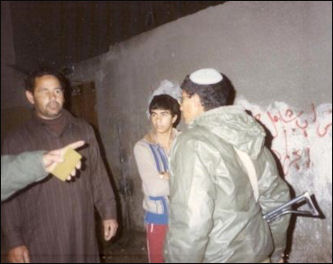
Erasing slogans On July 6, 1989, a Palestinian refugee from Gaza wrestled the steering wheel of a bus from the driver, causing the bus to plunge over a cliff outside of Jerusalem, killing 16 people, including the attacker, and injured 27.
In March 1991, one of the most brutal Palestinian attacks took place in East Jerusalem. A Palestinian man walked up to a bus stop with a butcher knife hidden under his jacket and viciously stabbed three women there and then stabbed and killed a man while he was running away. The man with knife was finally brought down by four bullets fired by a off-duty policeman who chased him. Two of the victims died. The killer survived and was treated at the same hospital as the injured victims. He was imprisoned in Israel and treated as a hero in the West Bank and Gaza Strip.
In August 1990, two Israeli teenagers were found with their faces stabbed so many times they were unrecognizable. Their deaths spurred violence and vigilante attacks that lasted for two days until a Palestinian man was dragged from his car and beaten to death. Some members of the mob called their acts of rage “the Jewish Intifada .” A few weeks late an Israeli army reservist and father of three made a wrong turn into a Palestinian refugee camp. With his yellow-Israeli license plate as a giveaway, a mob descended on his car. The Israeli was stoned until he lost consciousness and then gasoline was poured all over his car, which was then set ablaze with him in it.
Palestinian Victims of the Intifada

In May 1990, a former Israeli soldier discharged for mental reason opened fire with an M-16 on unarmed Arab workers south of Tel Aviv, killing seven of them. In an investigation of 1,250 cases in which Israeli troops killed Palestinians, only 15 soldiers are known to have been convicted of negligently using lethal force. Of these 11 were given suspended sentences of community service.
Some Palestinian victims were children. A 13-year-old with a broom stick was killed by an Israeli soldier who thought the broomstick was a gun pointed at him. In the split second he had to react he fired. An eight year girl was hit in the head with a rubber bullet and now can no longer speak. Another young girl saw her father beaten and her older sister killed, perhaps by Palestinians for collaborating with the Israelis. She no suffers headaches, insomnia, anorexia and nightmares .♥
Nablus was governed for many years by a mayor who had both of his legs blown off by a terrorist bomb believed to have been set by Israeli terrorists. If that wasn't enough afterwards he was placed under house arrests. In some cases houses of Palestinians were sealed or boarded up and its occupants were forced to live in tents set up outside their houses.
Collaboration with the Israelis is one of the worst Palestinian crimes. By one count 571 Palestinians were killed by other Palestinians during the Intifada.
On August 21, 1969, an Australian Christian religious fanatic set fire to the Al Aksa Mosque in Jerusalem, causing severe damage and sparking riots. He said he “did it to make Jesus come back” and said that could not happen until non-Christian s had been cleared from the Temple Mount.
When a 19-year-old Arab worker went on a rampage and knifed to death three Israelis in an affluent Jerusalem , Jewish mobs attacked Arab workers. The brother of one of the victim tried to climb into the grave during the funeral. Two months later he pumped an Arab car with 33 bullets, killing a man who had just picked up his wife at the hospital after she gave birth. After the incident the “Green line” (border between Israel and the Palestinian territories) was closed and security checkpoints were set up outside Jewish neighborhoods, checking any person who looked Arab or Palestinian and tried to enter. Afterwards there were rumors of more stabbings and reports of Israelis refusing to buy items that were thought had been touched by Arabs or Palestinians.
Israeli Crackdowns and End of the Intifada
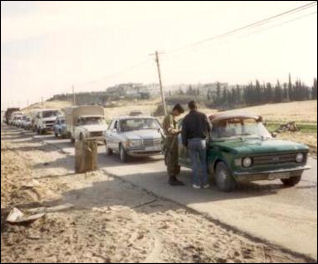
Jabalya roadblock The Israeli government of Yitzak Shamir imposed a curfew, prevented Palestinian workers from working in Israel and set up checkpoints and roadblocks. The Palestinian economy declined and ordinary Palestinians suffered. A permit system was implemented to reduce the number of Palestinian workers in Israel and they were required to be picked up at the special stops by special buses, The police were then given orders to check Palestinians for permits and arrest anyone who didn’t have a permit or who was found at an unauthorized bus stop. These moves limited the number of Palestinians entering Israel (the number of workers dropped from 130,000 to 80,000) but also made Palestinians angrier and more resentful.
After the Persian Gulf War in 1991, conditions worsened in the West Bank and Gaza Strip and the PLO was losing its authority while Palestinian militias were gaining more power. Three times as many Palestinians were killed by other Palestinians as by Israelis. The PLO lost much its financial and political support in the international community because it supported Iraq in the war and was looking for ways to remain relevant. Some suggested making peace with Israel.
The Intifada formally ended when the Palestinians were given limited self rule in 1994, but violence and repression continued. A new Intifada started in 2001 after Sharon visited the Temple Mount.
Attack in Hebron by Jewish Gunman Kills 29 Arabs and Palestinians
Cave of the Patriarchs On February 25, 1994, five months after the Oslo accord was signed, 29 people were killed and more than 130 were injured when a Jewish gunman opened fire on Palestinian worshipers at a mosque in Hebron in the West Bank at the Cave of the Patriarchs, where Abraham, the father of Christianity, Islam and Judaism, is buried along with his wife Sarah. The killing took place during the Muslim holiday of Ramadan.
It was the most blood shed in a single incident in Israel since the Six-Day war in 1967. The attack ended when an angry mob got a hold of the gunman and beat him to death with metal rods. Three other people were killed in the stampede. Five others were killed and 40 were injured in riots in Hebron that took place after the massacre. There were also riots in Palestinian refuge camps and other places. At the Temple Mount in Jerusalem, rioters threw rocks at Jews praying at the Wailing Wall. Palestinian groups claimed 63 Palestinians were killed.
The gunman, Dr. Baruch Goldstein, wore an Israeli army uniform. He walked past Israeli guards at the east entrance of the shrine and took up a position at the rear of the mosque and opened fire on a group of 400 to 500 praying Palestinians and Arabs with an Israeli-made Galil assault rifle. He fired 110 bullets and reloaded three times with a gun that uses 35-round magazines and is capable of shooting 175 rounds a minute. Most of the rounds were fired at the kneeling Muslims. Some bullets were fired at the overhead lights, plunging the room into darkness. People was amazed that so much killing could be achieved by a single person.
One witness told the Washington Post, “A lot of people were going to the mosque, many more than usual. But in recent days, the settlers have been annoying the worshipers. While we were praying, we could hear the settlers shouting, always shouting their prayers...I heard at least 100 bullets. We heard a lot of shooting from behind. They people who were shot fell back on the others. All the ground was full of blood, and most of the people were bloody...I tried to get out. I couldn’t walk. I felt my knee, I was shot, and I couldn’t find my 7-year-old. There was a lot of shooting. One victim told the Washington Post, “When I heard the shots, I felt the bullet. The man next to me — his brain was blown out f his skull. He raised his index finder, to show — when one feels death coming — that he believes God is one. I wanted to die. “
Hebron Killer and Israeli Soldiers During the Attack
Cave of the Patriarch's mosque Goldstein was a Jewish settler and a member of religious fanatic group called Kach. He was born in Brooklyn into an Orthodox family. He studied at Orthodox schools and had little contact with people other than Orthodox Jews. As he got older he became more political and militant and became a devote follower of Rabbi Kahane. After finishing his studied to be a medical doctor he moved to Israel.
In Israel, Goldstein joined the Israeli army as a physician and rose to the rank of major. Later he became close with Rabbi Kahane and helped organize his campaign to Parliament. According to people who knew him at his settlement he suffered a “mental crisis” brought on by treating so many Jewish victims of Arab and Palestinian attacks and by outrage over the Oslo Peace Accord and the perceived betrayal of Jewish settlers. After the killings Goldstein’s neighbors raised a statue to commemorate the mass murder. Hundreds of Jews showed up to Goldstein’s tomb to honor him. Many kissed and hugged his tombstone.
In the chaos that followed the massacre, Palestinians ran towards the east entrance trying to flee the attack. The area outside the eastern entrance was blocked, Palestinians could only run and north and south through the corridor. Three Israeli guards fired their weapons in a passageway outside the east entrance. Two of the guards fired into the air. According to reports by witnesses at least one soldier fired into the crowd, killing at least one Palestinian and wounding at least two. There was no suggestion they participated in the attack but rather panicked, not knowing who was firing and why, and fired their own weapons for their own protection. The Israeli army insisted their soldiers didn’t fire their weapons or shoot anyone. Its investigators said that all the bullet casings they found belonged to the weapon used by Goldstein. Israeli guards were also criticized for letting the gunman in to begin with.
Early Terrorist Attacks by Hamas in Israel
.png)
Suicide bombing in
Jerusalem February 25. 1994 By the early 1990s, the PLO had denounced terrorism. Most of the terrorist activities that took place after that were carried out by Hamas and Islamic Jihad. The first suicide bombing by an Islamist Palestinian took place in the West Bank in April 1993.
On June 30, 1993, three members of Hamas infiltrated East Jerusalem from the West Bank and boarded a bus heading to West Jerusalem. The driver thwarted their attempt to hijack the bus. The homemade bombs they brought with them failed to go off. In the end they pulled out guns they brought with them and fired at the bus passengers, injuring five of them including a woman who later died. The men escaped and hijacked a car. They were confronted by Israeli soldiers at a checkpoint. Two were shot dead. One was shot in the head. He lay in a coma for two months and was pronounced brain dead and given to his family in the Gaza Strip. He recovered and went on to raise a family.
The first suicide attacks were prompted by the attack at the mosque in Hebron on February 25, 1994, On April 6, 1994, a Hamas terrorist in a blue Opel with a bomb in the back seat drove up to bus at a bus stop in the Galilee town of Afula and pushed a metal button, blowing himself, two gas canisters, a bag of eight penny nails, killing eight other people and wounding 45. On April 13, 1994, a Hamas terrorist attached explosives to an Israeli commuter bus as it reached the town of Hadera. The explosion killed six people and wounded 25. A second bomb was found and defused. On October 19, 1994, a Hamas terrorist killed himself and 22 other people in a suicide bomb attack on an Israeli bus in a busy shopping district of Tel Aviv during rush hour. After the explosion the No. 5 bus was nothing but a skeleton of twisted metal. Around it were body parts and pieces of bus and clothing.
Terrorist Attacks by Islamic Jihad and Hamas in Israel in 1995
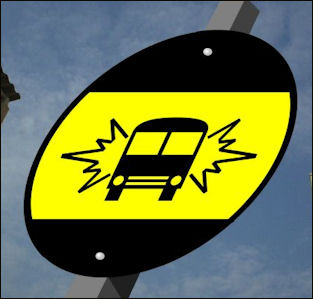
Tel Aviv bus stop On January 22, 1995, two powerful bombs exploded three minutes apart, killing 21 Israelis, all but one of them soldiers, and injuring 65, at a bus stop in Beit Lid near Netanya in central Israel. A surviving soldier said, “I didn’t know where I wanted to escape to. I didn’t know where to run. I was bleeding from the ear and from the nose. I saw a man cut up in front of me. I saw a head severed from a body. I didn’t know what was going on. I just wanted to run away.” Islamic Jihad claimed responsibility.
On April 6, 1995, two Islamic Jihad and Hamas suicide bombers killed seven Israeli soldiers and an American student by blowing themselves up on Israeli buses near the Jewish sentiment of Kfar Darom in the Gaza Strip. On July 24, 1995, a Hamas suicide bomber killed six people by blowing himself up on a commuter bus in the Tel Aviv suburb of Ramat. On August 25, a bomb exploded the No. 26 bus in northern Jerusalem, killing five people and injuring 107. The bomb contained 10 pounds of the chemical explosive 3-acetone. It was set off by an Arab passenger sitting at the back of the bus. The blast was so powerful it destroyed not only the bus in which the bomber was riding but also another bus riding along side it. Hamas claimed responsibility. Later a suicide bomber plowed into a Jewish settlement, killing 8 Jews and wounding 46.
The Israeli right denounced Israel Prime Minister Yitzak Rabin as a traitor to the Jewish people. Rightist hung posters with Rabin dressed as an Arab and displayed bumper stickers that read “The Nation versus Rabin.” Some even called Rabin a Nazi. At one rally a likeness of him was dressed in an SS uniform and burned in effigy. Rightists were angry with Rabin for making peace with the Palestinians and Jordanians and putting pressure on the Jewish settlers to leave the West Bank and Gaza Strip. Rabin was assassinated in November 1995.
Major Terrorist Attacks in Israel in 1996 and 1997
In February 1996, after six month lull, four suicide bombings left 58 Israelis dead. On February 25, a bomb exploded on Jerusalem bus, killing 25. On February 26 two Israeli soldiers were killed at a hitchhiking post near Ashqelon. On March 13, a suicide bomber attacked the same bus route in Jerusalem as the February 6 attack. Nineteen were killed. On March 4, a bomb exploded on a crowded street in Tel Aviv, killing 14. Hamas claims responsibility for the first and third bombings. Islamic Jihad took credit for the forth. The attacks occurred before the 1996 election. They are believed to have helped Netanyahu win and Peres lose.
Most of the attacks were orchestrated by Hamas leader Hassan Salameh, who was arrested and convicted of being responsible for 46 deaths and was sentenced to 46 consecutive life sentences in prison. He was quoted in the Los Angeles Times as saying he and three recruits carried three suitcases filled with TNT through a hole cut in an electric fence between Gaza and Israel. In Hebron he met up with Hamas contacts who said they had found two young men willing to blow themselves up.
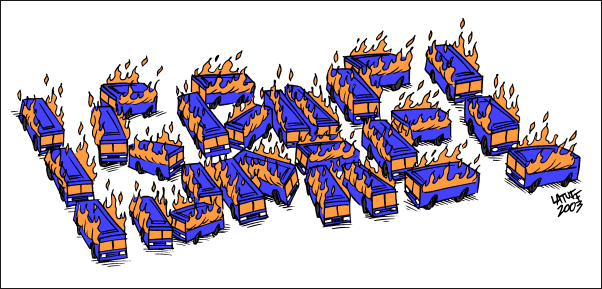
Salameh said, “I met the two young men and took them to my safe house in Abu Dis. I prepared two charges, each with 12 kilos of TNT, half a kilo of nails of different sizes and round metal pellets. I put everything into nylon bags and attached batteries and detonators...I explained to the two men how to use the bombs. One carried out the attack on the Jerusalem bus that killed 25. The other killed two Israeli soldiers at the hitchhiking post near Ashqelon. Later Salemeh found a third recruit and he killed 19 people on a the bus attack in Jerusalem.
On July 30, 1997, two suicide bombers blew themselves up outside Jerusalem’s main food market, killing 15 people, including themselves, and injuring 170. The two bombers were dressed in suits and each carried a bomb made of nails and screws packed with 10 kilograms of explosives placed in a briefcase. The two men were 30 meters apart and blew themselves up three seconds apart. The blasts blew away the lower bodies of the bombers but left their faces and heads intact. Hamas claimed responsibility for the attack.
In September 1997, three bombs on three suicide bombers exploded at Ben-Yehuda mall, a pedestrian shopping street in Jerusalem, killing seven and injuring dozens. All that was left of one of the bombers was a pair of legs. One witness told the New York Times, “When we heard the explosions we took cover, and a piece of flesh landed on me.” The bombings resulted in the ending of the peace process. Afterwards, in 1998 1md 1999, there was relatively little violence.
Image Sources: Wikimedia Commons
Text Sources: New York Times, Washington Post, Los Angeles Times, Times of London, The Guardian, National Geographic, The New Yorker, Time, Newsweek, Reuters, AP, AFP, Wall Street Journal, The Atlantic Monthly, The Economist, Global Viewpoint (Christian Science Monitor), Foreign Policy, Wikipedia, BBC, CNN, NBC News, Fox News and various books and other publications.
Last updated July 2012

